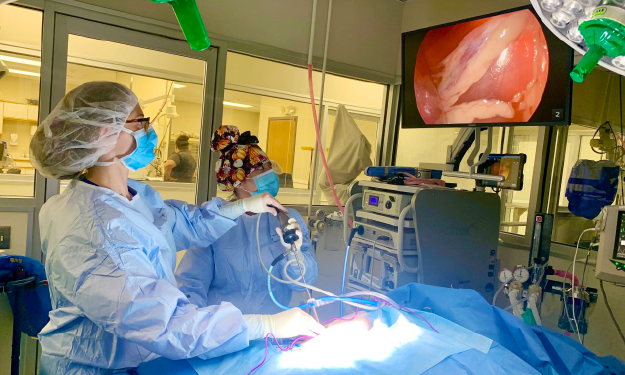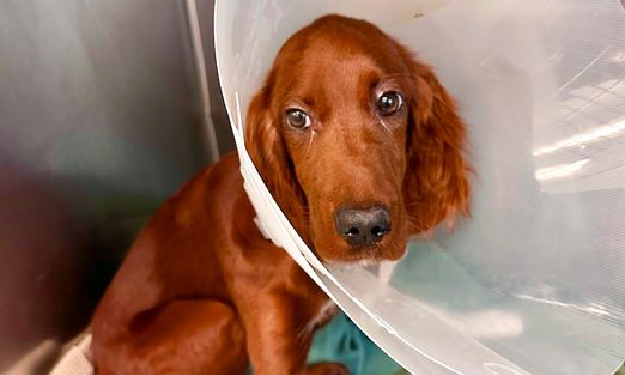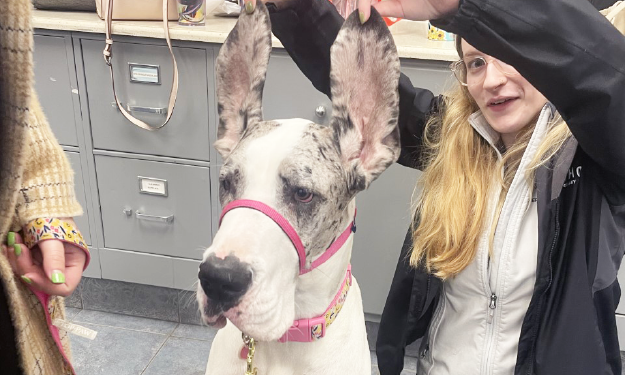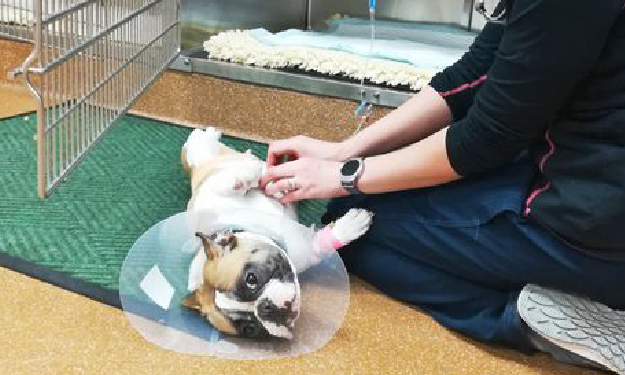Laparoscopic Spay for Dogs and Cats

What is a laparoscopic spay
Laparoscopy is “minimally invasive surgery” (MIS) within the abdominal cavity, sometimes called a “keyhole surgery” or “lap spay.” With laparoscopic procedures, small incisions are made to allow a camera to be placed within the abdomen. This camera allows the surgeon to see the structures inside the abdomen. 1-2 additional small incisions may be needed to introduce surgical instruments into the abdomen to perform surgery.
The alternative is a traditional “open approach” surgery, which requires a bigger incision.
A “spay” is a procedure to sterilize a female animal so that she cannot reproduce. There are two different surgical procedures that can achieve this goal:
- An ovariectomy is a surgery to remove the ovaries. Since this removes the hormones required to enter an estrus (or “heat”) cycle, as well as the hormones that promote and continue pregnancy, the animal will not enter estrus and cannot produce a litter. This is most common for a lap spay.
- An ovariohysterectomy is a surgery to remove both the ovaries and the uterus, hence also preventing estrus and pregnancy. This is also possible for a lap spay, but may require a slightly larger incision.
Why to consider a laparoscopic spay
Compared to a traditional “open approach” surgery, a lap spay uses smaller incisions. Although the body will still need to heal these incisions, it can allow a shorter recovery time and quicker return to function for the animal. This can typically take about 7 days compared to about 14 days.
Another benefit of MIS that seems counterintuitive, is that it provides enhanced visualization. For an open surgery, the surgeon sees things with their naked eyes (or sometimes magnifying glasses). For MIS, images from the camera are displayed on a large monitor, providing magnification of the area of interest.

This 5-month-old Irish Setter’s owner opted for a lap spay at Bulger Veterinary Hospital so she could have a faster, easier recovery.
How the laparoscopic spay is performed
- The entire underside of the abdomen is shaved and prepared for surgery.
- The abdominal cavity is filled with CO2 gas to provide an area for the surgeon to work.
- The camera incision is typically just behind the umbilicus or “belly button.”
- 1 or 2 additional incisions may be needed for instrument “portals.” Sometimes the instruments may be introduced through the same incision as the camera. Alternatively, the instrument portal(s) may be just behind the camera portal, or possibly off midline a little forward of the umbilicus.
- The instruments are used to identify and isolate the ovaries, as well as to cauterize the tissues so the ovaries can be safely removed from the abdominal cavity.
- If the uterus is also removed, it is often exteriorized through the camera portal and sutures placed around the part of the uterus that remains in the body, similar in an open approach.
- The CO2 is removed from the abdominal cavity and the incisions are sutured closed.
Combining the lap spay with other procedures
Other abdominal surgeries can also be performed at the time of a laparoscopic ovariectomy, just like with a traditional open approach. The most common procedure is a prophylactic gastropexy to prevent gastric dilitation-volvulus (“GDV” or “bloat”).

This Great Dane had a lap spay and gastropexy done simultaneously at Mass Vet Referral Hospital. Deep-chested & large breeds can benefit from this, including Great Danes, Irish Setters, Rottweilers, Poodles, and Weimaraners.
What makes a pet a good candidate for a laparoscopic spay
Consideration must always be given to the individual patient and includes their medical history, concurrent diseases or medical conditions, previous surgeries, anesthetic risk, etc.
Because of the need to introduce the instruments through the portals and fill the abdomen with CO2 to have space to work, this can be challenging in very small pets. Typically 15-20lb is the smallest animal this can be performed on, but there could be exceptions to this. Most cats are too small, but it may be considered for larger cats (i.e. Maine Coons) depending on the comfort of the surgeon.
Even if you have a smaller pet, you can still consider asking your pet’s surgeon about if they’re a good candidate for a lap spay.

Smaller dogs can benefit too! This French Bulldog had a laparoscopic spay done at Peak Veterinary Referral Center.
The cost for a laparoscopic spay
Your veterinary surgical team will provide a medical plan for your pet. Because of the use of advanced equipment, a laparoscopic spay includes some additional fees compared to a traditional open spay. However, when other procedures such as a prophylactic gastropexy are combined with a spay, the cost difference is proportionately less.
Why you should spay your pet
Prevent heat cycles & pregnancies
The most common reason to have a pet spayed is to prevent unwanted estrus cycles and pregnancies and to help prevent the overpopulation of dogs and cats which then end up in shelters looking for adoption or become homeless/feral animals.
Lower risk of cancer
Another benefit of spaying a pet is to decrease the risk of cancer. Studies have shown that removing the ovaries to decrease the sex hormones can decrease the risk of mammary cancer. Removing the ovaries will also eliminate the risk of ovarian cancer. If the uterus is not removed, it could develop cancer, so sometimes it is preferred to remove the uterus as well.
Lower risk of infection
Spaying an animal also decreases or eliminates the risk of pyometra, which is an infection of the uterus and can be a life-threatening surgical emergency. Removing the uterus eliminates the risk that it could become infected. By removing the ovaries, the risk of pyometra is greatly reduced because the pet will not go through heat cycles and thus vastly reduces the risk of uterine infection.